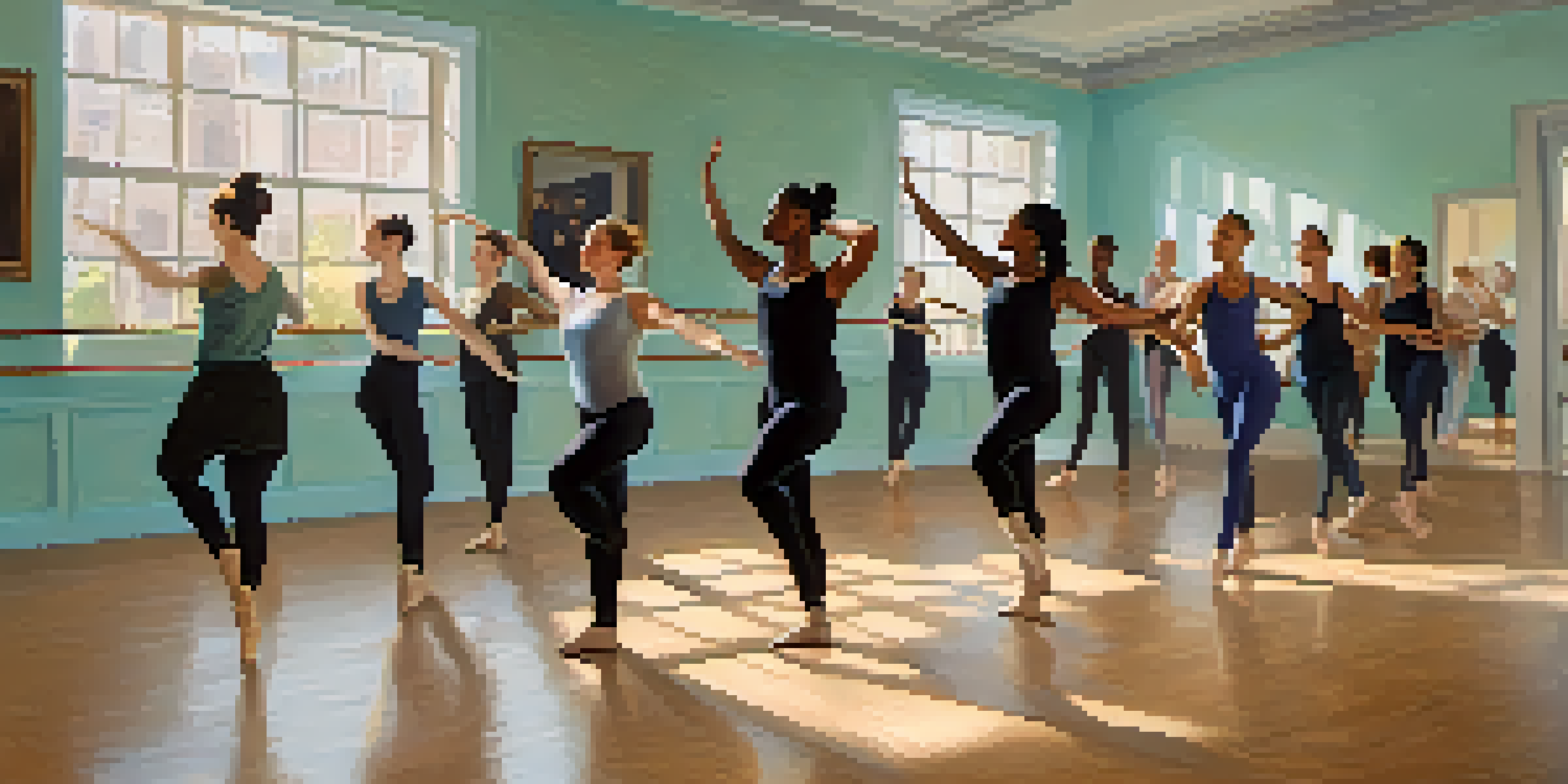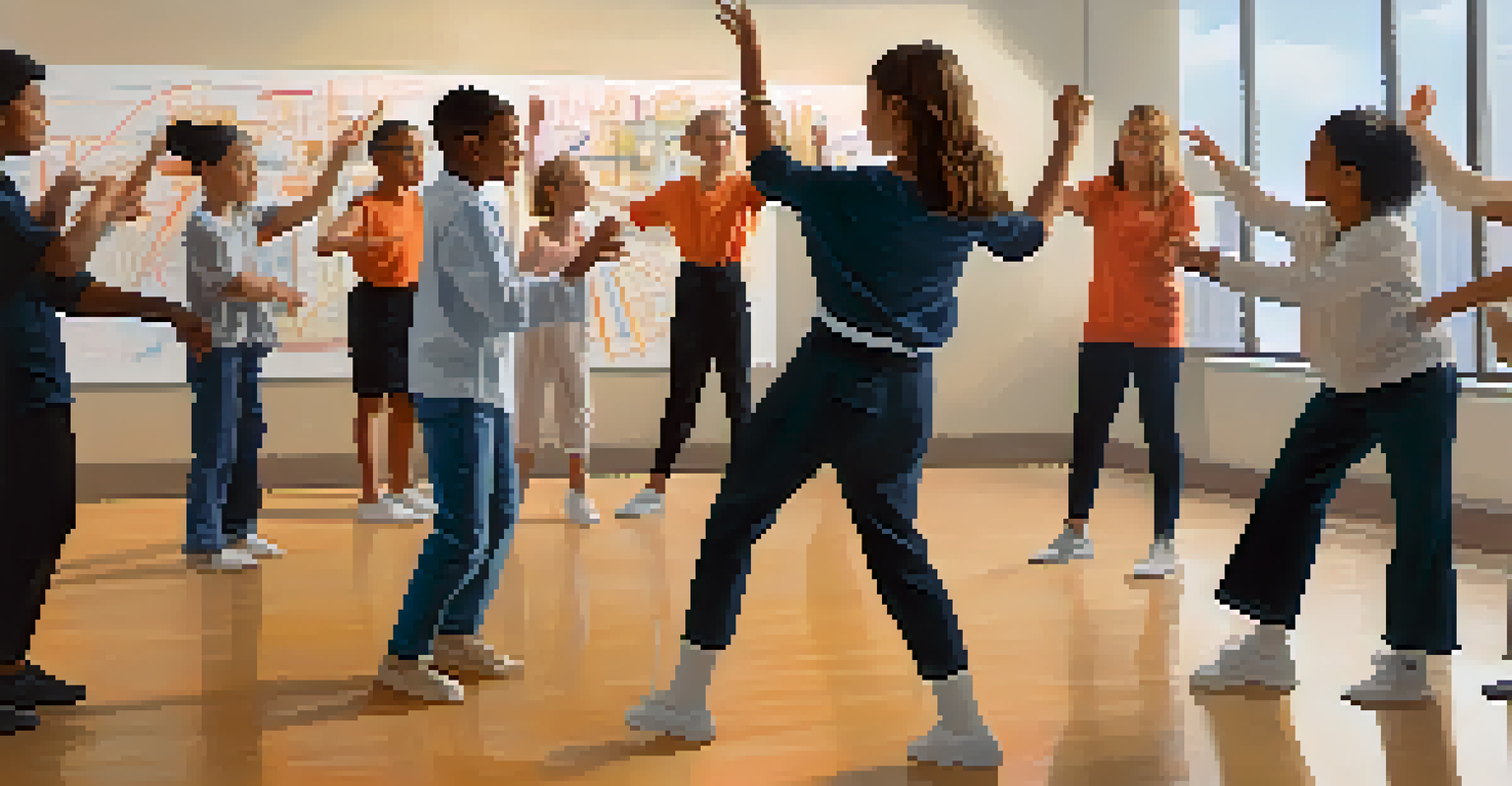Dance Workshops: Tailoring Experiences for Neurodiverse Needs

Understanding Neurodiversity in Dance Workshops
Neurodiversity recognizes that neurological differences, such as autism or ADHD, are natural variations of the human experience. In the context of dance workshops, this means creating an inclusive environment where everyone can express themselves. Understanding these differences helps facilitators design activities that cater to a wide range of sensory and social preferences.
Neurodiversity is not a disability but a different ability.
For instance, some individuals may thrive in a bustling, energetic setting, while others might find it overwhelming. By acknowledging these varied needs, dance workshops can be more inviting and enjoyable for all participants. This understanding fosters a sense of belonging and encourages creativity, allowing everyone to shine in their unique way.
Ultimately, embracing neurodiversity in dance not only enhances the experience for neurodiverse individuals but also enriches the group dynamic. When diverse perspectives come together, the creative possibilities are limitless, leading to a more vibrant and dynamic workshop atmosphere.
Creating Inclusive Dance Spaces
Creating a welcoming and inclusive dance space is crucial for neurodiverse participants. This can involve considering factors such as lighting, noise levels, and sensory stimuli. For example, soft, natural lighting and calming music can help reduce anxiety and make the environment more comfortable for everyone.

Additionally, providing a designated quiet area where participants can take breaks can be incredibly beneficial. This space allows individuals to recharge when feeling overwhelmed, ensuring they can fully engage in the workshop. By prioritizing sensory-friendly environments, facilitators can foster a sense of safety and security, encouraging participants to express themselves freely.
Embrace Neurodiversity in Dance
Creating an inclusive dance environment enhances creativity and allows participants to express themselves uniquely.
Inclusive spaces also mean promoting acceptance and understanding among all participants. Workshops should encourage open dialogues about neurodiversity, helping everyone appreciate each other's unique modes of expression and movement. This not only enriches the dance experience but also builds a supportive community.
Tailoring Dance Styles for Diverse Needs
Different dance styles can cater to various preferences and abilities, making it essential to tailor offerings in workshops. For instance, some participants may feel more comfortable with structured forms of dance, like ballet, while others might prefer the freedom of contemporary or improvisational styles. Offering a mix allows individuals to choose what resonates with them.
Dance is the hidden language of the soul.
Incorporating elements from diverse dance traditions can also enhance engagement. For example, introducing cultural dances can provide opportunities for storytelling and emotional expression, appealing to participants' different interests. By diversifying the dance styles presented, facilitators can create a more enriching experience that resonates with a broader audience.
Moreover, adapting choreography to be more accessible is key. Simplifying movements or breaking down complex steps can help ensure that all participants feel capable and confident in their abilities. This tailored approach encourages everyone to participate fully, irrespective of their dance background.
Utilizing Visual Supports and Clear Instructions
Visual supports, such as diagrams, videos, or demonstrations, can significantly enhance understanding in dance workshops. Many neurodiverse individuals benefit from visual learning, making it essential to provide clear, visual instructions alongside verbal guidance. This dual approach can help bridge comprehension gaps and ensure everyone is on the same page.
For instance, using step-by-step visuals for choreography can help participants remember movements more easily. Additionally, incorporating visual timers can aid in managing transitions during class, reducing anxiety related to changes. When participants know what to expect, they can focus more on enjoying the dance rather than worrying about the flow of the workshop.
Tailor Workshops for All Needs
Adapting dance styles and incorporating visual supports ensures that workshops cater to diverse preferences and abilities.
Moreover, encouraging participants to ask questions or request clarification fosters an open environment. When individuals feel comfortable seeking help, it promotes a culture of support and learning, allowing everyone to thrive together in their dance journey.
Incorporating Mindfulness and Movement Breaks
Mindfulness techniques can play a vital role in enhancing the dance experience for neurodiverse participants. Simple practices, like deep breathing or guided visualization, can help ground individuals before or during workshops. This mindful approach can ease anxiety and prepare participants to engage fully in the movements ahead.
Additionally, incorporating movement breaks throughout the workshop can be incredibly beneficial. These brief pauses allow participants to stretch, dance freely, or even relax, helping to maintain focus and energy levels. By recognizing the importance of movement variability, facilitators can create a more dynamic and engaging workshop environment.
Ultimately, integrating mindfulness and movement breaks into dance workshops not only supports neurodiverse needs but also enriches the experience for all participants. It encourages a holistic approach to dance, where mental and physical well-being are prioritized, creating a truly enjoyable atmosphere.
Fostering Social Connections Through Dance
Dance has a unique ability to bring people together and foster social connections. In workshops designed for neurodiverse participants, creating opportunities for collaboration and interaction is essential. Group activities, partner work, or even simple icebreakers can help build camaraderie and trust among participants.
Facilitators can also encourage non-verbal communication through dance, allowing individuals to express themselves without the pressure of traditional social interactions. This can be especially freeing for those who may struggle with verbal communication. When participants connect through movement, they often find a shared language that transcends words.
Foster Social Connections in Dance
Encouraging collaboration and non-verbal communication through dance builds trust and a sense of community among participants.
By fostering these social connections, dance workshops can create a supportive community where everyone feels valued and understood. These relationships not only enhance the workshop experience but also extend beyond the dance floor, promoting lasting friendships and a sense of belonging.
Evaluating and Adapting Workshops for Continuous Improvement
Continuous improvement is key to creating effective dance workshops for neurodiverse participants. After each session, facilitators should gather feedback from attendees to understand what worked well and what could be improved. This could include informal discussions or more structured feedback forms, allowing participants to share their experiences openly.
Analyzing this feedback can help identify patterns and preferences, guiding future workshop planning. For example, if many participants express a desire for more visual supports or specific types of dance styles, facilitators can adjust accordingly. This iterative process ensures that workshops remain relevant and responsive to participants' evolving needs.

Moreover, staying informed about best practices in neurodiversity and inclusive education can significantly enhance workshop quality. Attending training sessions, reading up on new research, or connecting with other facilitators can provide fresh insights and innovative ideas, ultimately benefiting the entire community.